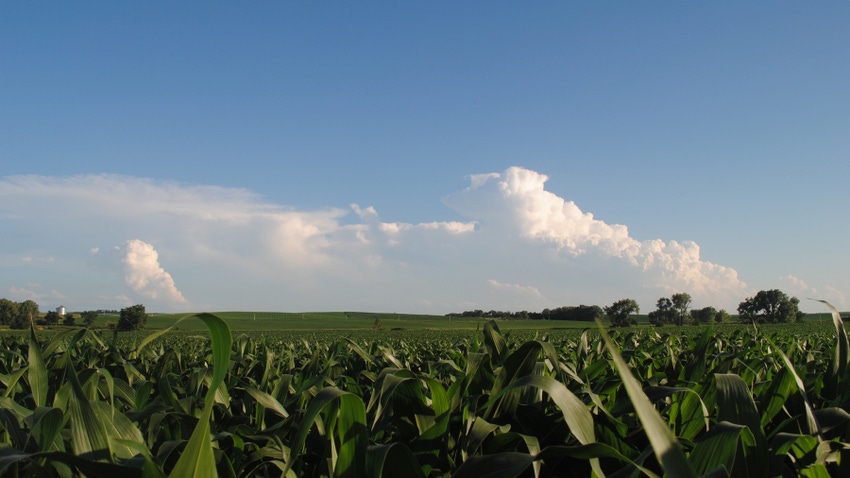
Farmers have been put through the wringer with drought conditions across parts of the Midwest. This caused producers to get creative to benefit their bottom line and keep the farm or ranch viable.
With planting season nearing, the overbearing question is if the Midwest and Plains states will be able to pull out of drought for the 2024 growing season.
Eric Hunt, Nebraska Extension agricultural meteorology and climate resilience specialist, covered this topic at the 2024 Corn and Soybean Expo, which was held recently at the Eastern Nebraska Research, Extension and Education Center near Mead.
With warm signals and projected precipitation, Hunt believes the region will see more precipitation for this upcoming growing season.
“You can never totally discount anything, but there's certain years where outcomes are a lot more likely than others,” Hunt said. “And I would be very, very surprised if this coming spring was as dry as the last one.”
Greener fields on horizon
Based on the weather patterns coming from the Southeast part of the country, Hunt predicts there will be more precipitation headed toward the eastern part of Nebraska from the Gulf of Mexico.
As for the western part of the state, the best indicator is the amount of precipitation that the Northern Plains and the Rocky Mountains are getting. Based off these indicators, Hunt predicts the eastern part of the state will recharge some of the soil. However, the western part of the state might experience drier conditions this upcoming growing season.
The timing of the rain is also something to monitor.
“The timing of it [precipitation] can be really important,” Hunt said. “If you get 8 inches of rain total between the first of June and the end of August, it technically would be under average. But if you start off with a good profile and that 8 inches is timed well, it is nothing to be concerned about. If a majority of those 8 inches is frontloaded or backloaded, then there could be issues.”
Using the U.S. Drought Monitor as a tool can be helpful when looking ahead to what growing conditions will look like. Hunt recommends looking at the “Change Maps” feature on the monitor’s website every week or so to see what has changed and compare it to previous weeks.
“I would also look at what's going on over in the ‘I states,’” Hunt said, “in part because history suggests that there is a strong price correlation for corn and soybeans with conditions in Iowa, Illinois and Indiana.”
Humidity concerns
While more precipitation forecasted for this upcoming growing season might excite farmers now, it is important to also be aware that there will be warmer temperatures associated with this. With the mix of added rain and heat, humidity will be on the rise.
Last year, there were optimal conditions for fungal and bacterial diseases because nighttime temperatures did not drop low enough, and cloudy conditions during the day made a perfect breeding ground for these diseases.
“So, I would tell producers to just be more cognizant of the higher humidity levels this summer and with more corn per capita in this part of the state, it will also increase humidity levels,” Hunt said.
But this humidity will not affect only row crop producers. With the projected humidity, livestock producers should be aware that nighttime temperatures might not drop low enough for the animals to dissipate the day’s heat.
“Last August was the absolute worst-case scenario,” Hunt said. “In the afternoons, we had excessive air temperatures, very high dew points, very light wind speeds, and temperatures didn’t drop much below 80 at night for several days.”
Being aware of these potential conditions now can allow producers to plan if something like August 2023 happens again.
Drawing from past
Right now, the Midwest is headed out of El Niño and headed toward La Niña. With El Niño bringing an average-to-wetter winter, as we enter La Niña, average-to-less-than-average precipitation can be expected.
The last time that the conditions of the El Niño-Southern Oscillation (ENSO) phenomenon was timed like this was in 2016 and 2010. Hunt expects that producers can expect conditions like this in the 2024 growing season.
Hunt can draw from the analogs of 2016 and 2010 because El Niño was peaking during the midwinter for the Northern Hemisphere.
“Previously in 2016 and 2010, we have seen winter patterns that were to some degree similar to those years now, though probably closer to 2016 in a general sense,” Hunt said.
Hunt draws from those years when there was more precipitation during the May-to-July period. Based on these predicted weather patterns, producers can expect to have timely rain during those times.
For further questions about the upcoming growing season, email Hunt at [email protected]. To see the different maps provided on the U.S. Drought Monitor, visit droughtmonitor.unl.edu.
Read more about:
WeatherAbout the Author(s)
You May Also Like






